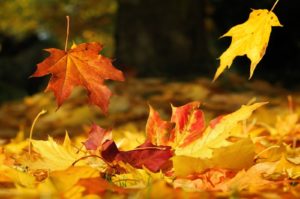
It never truly feels like we’ve left late summer behind until our first storm blows in. After a drizzly All Hallow’s Eve, the winds arrived, whipping the papery leaves the white oaks had deposited onto our moss-lawn. When we were finally able to begin clearing the tree debris, it was a near-perfect fall day: clear, breezy, mild temperatures. The unseasonably sunny skies made it more enjoyable to rake and gather the leaves, piling them into flower beds and tucking them into more hidden spots to protect and over-winter the garden.
While I don’t claim to love the blister I received from an overzealous need to tidy up, one of my great joys is being outside on an unexpectedly bright, crisp autumn day. I absolutely adore this time of year. It feels like a welcome respite after the go-go-go of summertime. Maybe the season resonates with me since we share the same dosha.
What is a dosha?
Doshas are a foundational concept in the ancient Indian holistic healing system of Ayurveda. In Sanskrit, Ayurveda means “the science of life” (ayus=life, veda=knowledge/science). Ayurveda has been in existence for thousands of years and is regarded as the “mother of healing.” It is thought to be the first organized healing system, with its theories influencing traditional Tibetan, Chinese and even ancient Greco-Roman healing.
Doshas are a mix of the five primal elements, or “states of existence,” in Ayurveda: air, water, fire, earth, and ether (space). These five elements make up everything and describe all the possible interactions of matter and energy. Each element is associated with certain qualities. Ayurvedic practitioners believe when these elements manifest in the body, they are condensed into three metabolic forces, or doshas.
There are three doshas in Ayurveda: Vata, Pitta and Kapha. Everyone is a mix of the three doshas, with one usually being predominant. Once you know your dosha, or where your tendencies are to go out of balance, then you can use diet, herbs and other remedies to bring you back to balance and good health.
Click here to find out what your dosha is.
The Vata dosha
The Vata dosha is a combination of the air and ether elements. Its qualities include movement, dryness, cold, light (as opposed to heavy), rough, and irregularity. A person with a strong Vata constitution tends to have a thin, light frame, dry skin, likes to talk, thinks, moves and speaks quickly, has cold hands and feet, is mentally alert, tends to be restless, and likes change. Autumn also embodies Vata characteristics as evidenced by cold, dry, windy weather. Wind personifies movement, restlessness and changeability, or irregularity.
Like increases like
One of the tenets of Ayurveda is “like increases like.” For example, if you have a Vata dosha and tend to be cold and dry, Autumn can exacerbate those qualities in you. Maybe your feet just can’t get warm or your skin feels especially taut or flaky. To counter an excess of Vata, you’ll want to balance your system with food and practices that are warming and grounding.
Ways to balance the Vata dosha
One of the simplest ways to balance Vata is by eating seasonal foods. Mama Nature knows exactly what we need to thrive and does her part to provide us with grounding and nourishing foods this time of year. Root vegetables like sweet potatoes, carrots, beets are abundant as well as “winter squashes” like pumpkin, butternut, acorn, delicata and spaghetti squashes. Warming spices like cinnamon, ginger, cloves, and cardamom also help to balance cold Vata.
Another nourishing practice is oleation (oil massage), or abhyanga. This self-indulgent, self-care practice boasts numerous health benefits including adding a layer of protection against the cold, keeping the skin moisturized in dry air, and calming the nervous system.
Too much Vata energy can lead to feeling spacey, fearful or acting flighty. Gentle, purposeful movement like seated yoga poses and active meditation practices (particularly grounding) help cultivate calm and stability amidst the chaos.
Whether you have a Vata dosha or not, fall is not the time for salads and other “cooling” foods and spices. Enjoy the tastes of the season and think warming, nourishing, and grounding to get the most benefit and maintain a healthy balance leading into the colder months.
